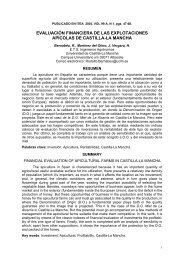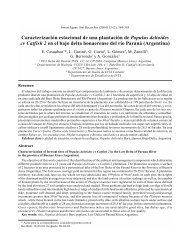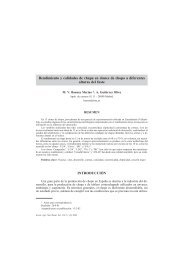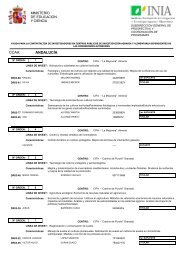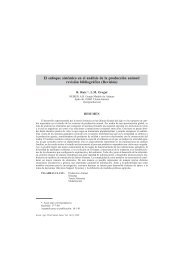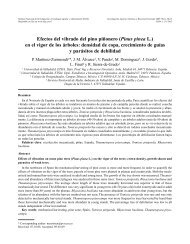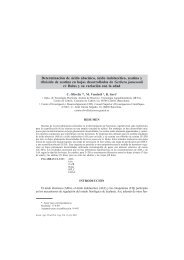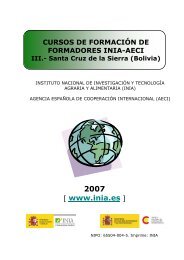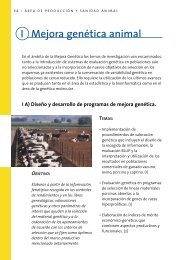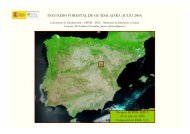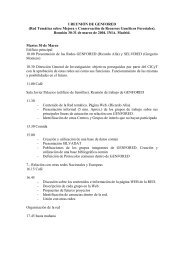Status of medicinal and aromatic plants in - Inia
Status of medicinal and aromatic plants in - Inia
Status of medicinal and aromatic plants in - Inia
Create successful ePaper yourself
Turn your PDF publications into a flip-book with our unique Google optimized e-Paper software.
PRESENTED PAPERS 73<br />
Conservation <strong>of</strong> <strong>medic<strong>in</strong>al</strong> <strong>and</strong> <strong>aromatic</strong> <strong>plants</strong> <strong>in</strong> Lithuania<br />
Jolita Radušienė<br />
Institute <strong>of</strong> Botany, Vilnius, Lithuania<br />
Introduction<br />
The use <strong>of</strong> wild <strong>medic<strong>in</strong>al</strong> <strong>and</strong> <strong>aromatic</strong> <strong>plants</strong> (MAPs) is widespread <strong>and</strong> has old traditions<br />
<strong>in</strong> Lithuania, especially <strong>in</strong> forested areas <strong>in</strong> the southern <strong>and</strong> southeastern parts <strong>of</strong> the<br />
country. About 100 taxa are still harvested from the wild for <strong>medic<strong>in</strong>al</strong> purposes,<br />
represent<strong>in</strong>g a significant part <strong>of</strong> the Lithuanian natural biodiversity which comprises 1323<br />
vascular plant taxa. The changes <strong>in</strong> political <strong>and</strong> economic life (Lithuania rega<strong>in</strong>ed its<br />
<strong>in</strong>dependence <strong>in</strong> 1991) have <strong>in</strong>creased the dem<strong>and</strong> for MAPs <strong>and</strong> therefore determ<strong>in</strong>ate the<br />
importance <strong>of</strong> germplasm conservation. Active conservation <strong>of</strong> MAPs is pursued with<strong>in</strong> the<br />
context <strong>of</strong> the National State Plant Genetic Resources Programme (1998-2002).<br />
The Nordic Gene Bank has made a substantial contribution <strong>in</strong> start<strong>in</strong>g <strong>and</strong> develop<strong>in</strong>g<br />
plant genetic resources (PGR) conservation activity <strong>in</strong> Baltic countries. The Nordic-Baltic<br />
collaborative project on PGR for food <strong>and</strong> agriculture was <strong>in</strong>itiated <strong>in</strong> 1994 <strong>and</strong> is still<br />
ongo<strong>in</strong>g (Weibull 2001). The MAP work<strong>in</strong>g group is one <strong>of</strong> the crop-specific work<strong>in</strong>g groups<br />
with<strong>in</strong> this project. The new project SPIMED (Spice <strong>and</strong> <strong>medic<strong>in</strong>al</strong> <strong>plants</strong> <strong>in</strong> the Nordic <strong>and</strong><br />
Baltic countries. Strategies for conservation <strong>of</strong> genetic resources) started <strong>in</strong> 2002.<br />
This paper provides a brief review <strong>of</strong> the current research <strong>and</strong> activities deal<strong>in</strong>g with<br />
MAP germplasm conservation <strong>in</strong> Lithuania.<br />
Material <strong>and</strong> methods<br />
The analysis <strong>of</strong> trade figures is based on data collected by the governmental Department <strong>of</strong><br />
Statistics <strong>and</strong> the Division <strong>of</strong> Plant Resources <strong>of</strong> the M<strong>in</strong>istry <strong>of</strong> Environment <strong>in</strong> 1996-2001.<br />
Target species for conservation were selected on the basis <strong>of</strong> their current economic value,<br />
usefulness for breed<strong>in</strong>g <strong>and</strong> conservation status. The evaluation <strong>of</strong> accessions was carried<br />
out accord<strong>in</strong>g to the morphometric analysis <strong>of</strong> the phenotype <strong>and</strong> the quality <strong>and</strong> quantity <strong>of</strong><br />
secondary metabolites. Analytical methods were employed for chemical evaluation <strong>of</strong> the<br />
raw material <strong>of</strong> target species. Spectrophotometry was used for the determ<strong>in</strong>ation <strong>of</strong> total<br />
flavonoids. The quantitative analysis <strong>of</strong> phenolic compounds was carried out by a modified<br />
HPLC gradient elution method (Hölzl <strong>and</strong> Ostrowski 1987). Essential oils were isolated by<br />
hydro-distillation. GC <strong>and</strong> GC–MS analyses were performed for qualitative <strong>and</strong> quantitative<br />
evaluation <strong>of</strong> the essential oils.<br />
The species distribution maps were prepared on the basis <strong>of</strong> herbarium data from the<br />
Institute <strong>of</strong> Botany <strong>and</strong> Vilnius University <strong>and</strong> our observations on MAP sources.<br />
Results <strong>and</strong> discussion<br />
• The trade <strong>in</strong> MAPs<br />
The average annual volume <strong>of</strong> plant material com<strong>in</strong>g from the wild represents about 29% <strong>of</strong><br />
the total volume used <strong>in</strong> pharmaceutics. This means that about 85 t dry raw material is<br />
extracted from the wild populations yearly (Fig. 1). The most frequently used native species<br />
<strong>in</strong> herbal medic<strong>in</strong>e are Crataegus sp., Arctostaphylos uva-ursi, Menyanthes trifoliata, Hypericum<br />
perforatum, Thymus serpyllum, Tussilago farfara, Polygonum aviculare, Urtica dioica <strong>and</strong> Frangula<br />
alnus.




